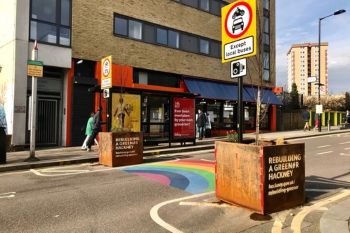
Low-traffic neighbourhoods (LTNs) reduce traffic and air pollution without displacing the problem to nearby streets, new research has shown.
Researchers at Imperial College London looked at three LTNs in London, to identify their impact on air pollution, as well as traffic both within the LTN zones and in the surrounding area.
LTNs aim to reduce through traffic in residential areas, usually by the use of barriers that stop cars using streets as rat runs, but leave them open to pedestrians and cyclists.
The researchers studied three LTNs that were put in place in Islington during 2020, comparing pollution and traffic levels at monitoring stations inside the zones, on streets surrounding the zones, and at control sites further away, using data gathered by Islington Council from July 2019 to February 2021.
Using a ‘complex statistical analysis’, the researchers found that concentrations of nitrogen dioxide fell by 5.7% within the LTNs and by just under 9% on their boundaries, compared to the control sites. They also found that traffic dropped by over half inside the LTNs and by 13% at the boundaries, compared to the controls.
Dr Audrey de Nazelle from Imperial’s Centre for Environmental Policy said: ‘This research effectively disproves the argument that low-traffic zones will necessarily cause an increase in traffic and air pollution in neighbouring streets.
‘In the three areas we looked at, they reduced both traffic volumes and, significantly, air pollution both inside and on the edges of the zone. Alongside the other benefits of LTNs that have been shown in previous research – such as improvements in safety and an increase in walking and cycling – this makes a very strong argument in their favour.’
Imperial College PhD student Helen Yang, a co-author of the research, added: ‘This is the first study to use a robust statistical approach to show the impact of LTNs on surrounding areas, and the results are really encouraging.
‘We worked with a relatively small data set and further research is now needed to confirm these findings at a larger scale.’
This article was first published by Transport Network.












